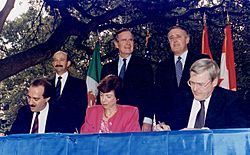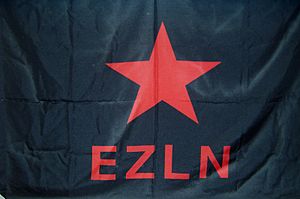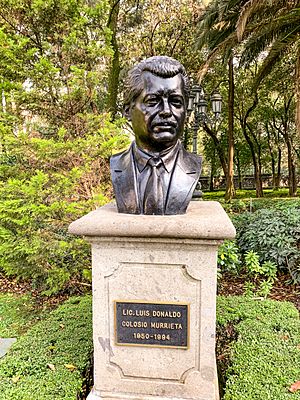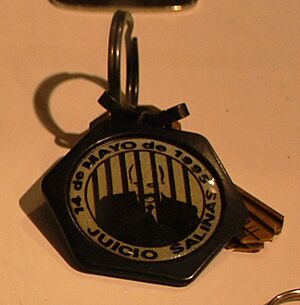Carlos Salinas de Gortari facts for kids
Quick facts for kids
Carlos Salinas de Gortari
|
|
|---|---|

Official portrait, 1988
|
|
| 60th President of Mexico | |
| In office 1 December 1988 – 30 November 1994 |
|
| Preceded by | Miguel de la Madrid |
| Succeeded by | Ernesto Zedillo |
| Secretary of Programming and Budget of Mexico | |
| In office 1 December 1982 – 5 October 1987 |
|
| President | Miguel de la Madrid |
| Preceded by | Ramón Aguirre Velázquez |
| Succeeded by | Pedro Aspe |
| Personal details | |
| Born | 3 April 1948 Mexico City, Mexico |
| Citizenship |
|
| Political party | Institutional Revolutionary Party |
| Spouses |
Cecilia Occelli
(m. 1972; div. 1995)Ana Paula Gerard
(m. 1995) |
| Relations | Raúl Salinas de Gortari (brother) José Francisco Ruiz Massieu (brother-in-law, deceased) Elí de Gortari (uncle, deceased) |
| Children | 6, including Emiliano |
| Parents | Raúl Salinas Lozano Margarita de Gortari Carvajal |
| Education | National Autonomous University of Mexico (BA) Harvard University (MPA, MA, PhD) |
| Signature |  |
Carlos Salinas de Gortari (born 3 April 1948) is a Mexican economist, historian, and former politician. He served as the 60th president of Mexico from 1988 to 1994. He is known for promoting and signing the North American Free Trade Agreement (NAFTA). He was a member of the Institutional Revolutionary Party (PRI). Before becoming president, he worked in the government's budget department. He became president after an election that had many questions about fairness.
Salinas was an economist, which was unusual for a Mexican president at that time. His time as president focused on economic policies that encouraged free trade and less government control. Many state-owned companies were sold to private owners, and banks were privatized again. Mexico also joined NAFTA during his term. He worked with the opposition party, PAN, to recognize their wins in local elections. He also improved relations with the Catholic clergy.
His presidency saw economic growth for a while. However, his last year in office faced many challenges. These included a rebellion in Chiapas and the tragic deaths of important political figures. After he left office, Mexico faced a major economic crisis. His brother also faced serious legal issues. Carlos Salinas then left the country for some time. He is often seen as one of Mexico's most influential and debated politicians since the 1990s.
Contents
Early Life and Education
Carlos Salinas de Gortari was born on 3 April 1948 in Mexico City. He was the second of five children. His father, Raúl Salinas Lozano, was an economist and government official. His father served as a minister for President Adolfo López Mateos.
Salinas studied economics at the National Autonomous University of Mexico. He was active in the PRI youth movement. He was also a skilled horseman and competed in the 1971 Pan American Games in Colombia.
He continued his studies at Harvard University in the United States. He earned a master's degree in Public Administration in 1973. He then completed his PhD in 1978. His doctoral paper was about how social programs could help governments gain support.
Personal Life
Carlos Salinas met his first wife, Cecilia Yolanda Occelli González, when they were children. They started dating as teenagers and married on 15 April 1972, in Mexico City. They moved to Boston while Salinas studied at Harvard. Their first daughter, Cecilia, was born in 1974. They had two more children, Emiliano (born 1976) and Juan Cristobal (born 1978).
Cecilia Occelli González was the First Lady of Mexico during his presidency (1988-1994). They divorced in 1995, shortly after he left office.
Salinas then married his second wife, Ana Paula Gerard Rivero, in 1995. She had worked in his administration. They had three children: Ana Emilia Margarita (born 1996), Patricio Gerónimo Gerardo (born 1998), and Mateo (born 2006). In 2021, he also gained Spanish citizenship.
Early Political Career
In 1982, President Miguel de la Madrid chose Salinas to be the Minister of Planning and Budget. This was a very important job because Mexico was facing a severe financial crisis. The country had no money reserves and a lot of debt. Salinas worked to deal with these economic problems. He formed alliances with other powerful figures in the government.
Presidential Election 1988
The 1988 election was a very challenging time for the PRI. For the first time, they faced strong opposition from both left and right-wing parties. Cuauhtémoc Cárdenas, the son of former President Lázaro Cárdenas, ran as a candidate from a left-wing group. He quickly became very popular.
On election day, 6 July 1988, the computer system used to count votes "crashed." When it was fixed, Carlos Salinas was announced as the winner. Many people believed there was widespread fraud. The phrase se cayó el sistema ("the system crashed") became a common way to talk about election fraud. Later, the Congress voted to destroy the election documents without opening them. This made many people even more suspicious.
Some people believe Salinas did win, but perhaps not by as much as the official results showed. Former President Miguel de la Madrid later suggested that the PRI had lost many voters in that election.
Presidency 1988–1994
Salinas became president on 1 December 1988. His main goal was to "modernize" Mexico. He wanted to update politics, the economy, and society to meet the needs of Mexicans.
First Steps and Economic Changes
Right after taking office, Salinas took strong actions. He arrested powerful union leaders. His government also sold many state-owned companies, including the phone company Teléfonos de México. Banks that had been taken over by the government were sold back to private owners. The money from these sales helped Mexico pay off its national debt.
Salinas continued the economic policies of the previous president. He focused on making Mexico a free-market economy. During his term, inflation (prices rising) was reduced significantly. However, shortly after he left office, inflation rose again due to an economic crisis.
Helping People and Human Rights
Salinas started a program called the National Solidarity Program (PRONASOL). This program aimed to help poor Mexicans directly. It used public money, often from the sale of state companies, to improve roads, electricity, schools, and clinics in poor areas. This program was also seen as a way for Salinas to gain public support.
In 1990, the National Human Rights Commission was created. This organization worked to protect human rights in Mexico.
Church and State Relations
Mexico's government and the Catholic Church had a difficult history. There were many rules limiting the Church's role in public life. Salinas worked to improve these relations. He announced a plan to "modernize" Mexico's relationship with the Church. This led to changes in the 1917 Constitution, which had placed many restrictions on religious organizations.
Electoral Reforms
After the controversial 1988 election, Salinas's government made changes to how elections were run. A major change was creating the Federal Electoral Institute (IFE) in 1990. This new group was independent and took over managing elections from the Ministry of the Interior.
The 1994 elections were the first to have international observers. They were considered the fairest elections in many years. For the first time, the PRI lost its two-thirds majority in Congress.
North American Free Trade Agreement (NAFTA)
A major achievement of Salinas's presidency was the creation of the North American Free Trade Agreement (NAFTA). This agreement with the United States and Canada started on 1 January 1994. NAFTA aimed to create a single market between the three countries. Mexico hoped it would attract foreign investment, create jobs, and help its economy grow. This agreement was a big change from Mexico's past economic policies.
Foreign Policy
Salinas also worked to improve Mexico's standing in the world. He renegotiated Mexico's foreign debt. In 1992, Mexico hosted the Chapultepec Peace Accords, which helped end a civil war in El Salvador. Mexico also rejoined diplomatic relations with the Vatican. Mexico became a member of important international groups like the Asia-Pacific Economic Cooperation (APEC) and the Organisation for Economic Co-operation and Development (OECD).
1994 Election Year Challenges
As the 1994 presidential election approached, Salinas had to choose the next PRI candidate. This person usually went on to win the presidency. However, a series of events in his final year changed everything.
Zapatista Rebellion
On 1 January 1994, the same day NAFTA began, a rebellion started in Chiapas, southern Mexico. The Zapatista Army of National Liberation (EZLN) announced their presence. Salinas quickly sought a peaceful solution. He offered pardons and ordered a ceasefire. This rebellion brought international attention to Mexico's poor regions. It also disrupted Salinas's plans for a smooth political transition.
Tragic Death of the PRI Candidate
In March 1994, Luis Donaldo Colosio, the PRI's chosen presidential candidate, was tragically killed. This event greatly complicated the election. Salinas then chose Ernesto Zedillo, his former Minister of Education, as the new PRI candidate. Zedillo had not held an elected office before and was seen as a less experienced politician.
1994 General Election
- Further information: 1994 Mexican general election
Despite the challenges, the general election took place as planned on 21 August 1994. Many voters participated. Zedillo won the election, which foreign observers considered free and fair.
Another Political Tragedy
After the election, in September 1994, José Francisco Ruiz Massieu, the PRI's Secretary General and Salinas's former brother-in-law, was also tragically killed in Mexico City. The case was not solved during Salinas's presidency.
Economic Issues at the End of His Term
Mexico had experienced a period of economic growth and low inflation. Some people thought Mexico was becoming a "First World nation." However, the Mexican currency (the peso) was overvalued. Several economic mistakes and unexpected events in Salinas's last year made the economy vulnerable. The government spent a lot of money, leading to a high deficit. To cover this, the government issued special bonds that promised payment in dollars. This caused alarm among investors, who quickly sold their bonds. This led to a sharp drop in Mexico's dollar reserves.
Successor's First Days and Crises
Peso Devaluation
Soon after Ernesto Zedillo became president, his government announced a change in the peso's value. The peso quickly lost a lot of its value against the US dollar. This led to a major economic crisis in Mexico. Many businesses faced difficulties, and people lost their jobs.
Salinas blamed Zedillo for the crisis, calling it the "December mistake." He argued that he had planned a gradual devaluation of the peso.
Break with Zedillo and Self-Exile
In February 1995, Salinas's older brother, Raúl Salinas de Gortari, was arrested on serious accusations. This event caused a major shift in Mexican politics. Carlos Salinas publicly expressed his anger at Zedillo. He blamed Zedillo for the economic crisis.
Salinas then left Mexico and lived in Ireland for a period.
Post-Presidential Years
Salinas's reputation continued to be affected by issues involving his family. His brother Raúl's arrest led to investigations into a large amount of money found in bank accounts around the world. In 2008, Switzerland returned a large sum of money from Raúl Salinas's frozen accounts to the Mexican government.
In January 1999, after a long trial, Raúl Salinas was found guilty of ordering the death of a PRI official. He was sentenced to prison, but his conviction was later overturned in 2005, and he was freed. In December 2004, Salinas's youngest brother, Enrique Salinas, was found dead. The case remains unsolved.
Carlos Salinas returned to Mexico in the late 1990s. He published a book defending his presidency and blaming Zedillo for the economic crisis that followed. He has continued to be an influential figure in Mexican politics.
Honours
Foreign Honours
 Spain:
Spain:
 Knight of the Collar of the Order of Isabella the Catholic (1990)
Knight of the Collar of the Order of Isabella the Catholic (1990)
 Malaysia:
Malaysia:
 Uruguay
Uruguay
See also
 In Spanish: Carlos Salinas de Gortari para niños
In Spanish: Carlos Salinas de Gortari para niños
- List of heads of state of Mexico
- History of Mexico
- Politics of Mexico





